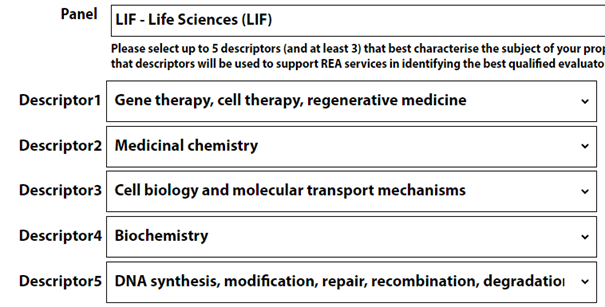How to choose the panel and descriptors for your MSCA-DN proposal
24th October 2024 at 1:43 pm
Thousands of researchers across Europe are currently busy preparing their Doctoral Network (DN) proposals for submission by 27 November 2024. Most DN consortia have probably started their proposal writing journey by defining the PhD topics, i.e. the Doctoral Candidates` (DC) project descriptions and the work packages in which up to 15 DC projects are clustered. In parallel, the partner profiles for Part B2 have most likely already been requested from the Beneficiary and Associated Partners, and the administrative forms in the EU Funding and Tenders Portal, namely Part A, are being populated.
However, based on our nearly two decades of DN proposal writing experience, network coordinators think about the descriptors to be selected for each DN rather late in the process. While the choice of MSCA-DN panel is, in many cases, obvious, the descriptors are less so. Given that the descriptors might or are likely to determine the selection of suitable reviewers for the proposals` evaluation by the Research Executive Agency, we would recommend making the choice early on in the process and as soon as possible as these will guide you in drafting the proposal and using most relevant terminology.
Which Evaluation Panel to choose?
There are eight panels for different research areas to choose from as shown here.

All DNs, be they standard DNs, Industrial Doctorates (DN-IDs) or Joint Doctorates (D-JDs) are submitted to these panels and compete against each other. As most proposals are multi-disciplinary these days, it is common practice to choose the panel that reflects the research topic of your proposal. For example, the development of a nano-carrier for drug development could fall into Chemistry and Life Sciences. Although the choice of the “right” panel will most likely ensure that your proposal will be evaluated by three independent reviewers from these broad areas, they might not be experts in your specific fields of research.
What Descriptors to select?
Hence, selecting suitable Descriptors, i.e. fixed keywords, might even be more important and guide you through the proposal writing and wording. The list of available Descriptors for each Evaluation Panel is available on the Research Executive Agency’s website. As there are hundreds of Descriptors, these are grouped into subcategories. For example, the Life Science Panel has seven categories or so-called sub-areas with 84 Descriptors.
- L1 – Molecular and Structural Biology
- L2 – Genetics, Genomics, Bioinformatics and Systems Biology
- L3 -Cellular and Developmental Biology
- L4 – Physiology, Pathophysiology and Endocrinology
- L5 – Neurosciences and neural disorders
- L6 – Immunity and infection
- L7 – Diagnostic tools, therapies and public health
Maximum five Descriptors can be selected from a drop-down menu in the A1 form of the online forms for your registered DN proposal in the EU Portal. The first descriptor must be chosen from the panel to which the proposal is being submitted to and from the subcategory most relevant to your research. It should be the one which best characterises the subject of the proposal. All other Descriptors may be chosen from any of the panels. But how to decide which and how many other Descriptors to choose?
First of all, most or all Descriptors should be selected from your chosen Evaluation Panel. Second, if your proposal includes different disciplines covered by two or more Panels, it might make sense to select one or more Descriptors from other Panels. We think it is important to find the right balance between the Descriptors of your chosen Panel and some additions from other Panels. Here is an example:

Third, we would recommend using the maximum number of Descriptors that are meaningful for your proposal and to attract a range of suitable reviewers.
Additionally, you need to insert free keywords in the A1 form online, which will help you further refine your proposal definition. These keywords should be project-specific and can be max. 200 characters including spaces. We usually define these together with the DN coordinator at the very end of the proposal preparation, together with the drafting of the abstract that also needs to be included in Part A.
How can accelopment support your DN project?
Continuing our success from Horizon 2020, we are pleased to already be involved in the seven ongoing Horizon Europe DNs MobiliTraIN, DarChemDN, CONcISE, BREAKthrough, MIRELAI, MITGEST, and SYNSENSO. Part of this achievement results from our long-standing experience of over 14 years in supporting and partnering with DNs since FP7. In DNs, we provide professional assistance with Project Management, communication activities and dissemination measures. Additionally, we contribute to their training programmes with our transferable skills courses on research project management, science communication, data management, gender equality, funding opportunities and grant writing.
Want to stay informed?
We regularly publish blog posts on Doctoral Networks. You can subscribe to our blog updates in the main area of our blog.

Jacqueline Strehler
Research & Innovation Project Manager
